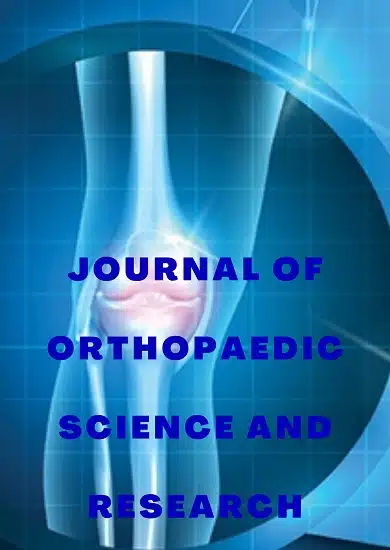Research Article | Vol. 6, Issue 2 | Journal of Orthopaedic Science and Research | Open Access |
Achieving a Spherical Femoroplasty During Hip Arthroscopy with Computer Assisted Visualization Software: A Prospective Single-Blinded Randomized Controlled Multi-Surgeon Study
Benjamin D Kuhns1, Elizabeth G Walsh1, Ajay C Lall1,2, Benjamin G Domb1,2*
1American Hip Institute Research Foundation, Chicago, IL 60018, USA
2American Hip Institute, Chicago, IL 60018, USA
*Correspondence author: Benjamin G Domb, MD, American Hip Institute Research Foundation, Chicago, IL 60018, USA and American Hip Institute, Chicago, IL 60018, USA; Email: [email protected]
Citation: Kuhns BD, et al. Achieving a Spherical Femoroplasty During Hip Arthroscopy with Computer Assisted Visualization Software: A Prospective Single-Blinded Randomized Controlled Multi-Surgeon Study. J Ortho Sci Res. 2025;6(2):1-10.
Copyright© 2025 by Kuhns BD, et al. All rights reserved. This is an open access article distributed under the terms of the Creative Commons Attribution License, which permits unrestricted use, distribution, and reproduction in any medium, provided the original author and source are credited.
| Received 01 May, 2025 | Accepted 19 May, 2025 | Published 27 May, 2025 |
Abstract
Background: Surgical correction of the cam deformity in patients with Femoroacetabular Impingement (FAI) through femoroplasty is one of the most technically demanding aspects of hip arthroscopy with inaccuracies directly impacting patient outcomes. This study aims to evaluate intraoperative femoroplasty time and radiation exposure in patients undergoing cam resection randomized to the use of image-based Computer-Assisted Visualization (CAV) software versus conventional fluoroscopy.
Methods and Findings: Patients undergoing hip arthroscopy for cam dependent FAI in a high-volume hip preservation practice with two experienced hip preservation surgeons (one senior, one junior) were prospectively enrolled in the study. Randomization into the conventional fluoroscopy (control) or CAV arms was performed at the time of surgery. Surgical data, as well as preoperative and postoperative radiographic indices were evaluated. There were 18 patients in the control group and 19 patients in the CAV group. There were no significant differences when comparing the control and CAV groups on the basis of femoroplasty time (17.8 ± 10.2 vs. 23.4 ± 15.8 minutes; p=0.26) or fluoroscopic exposure time (39.8 ± 36.4 vs. 56.8 ± 79.8 seconds; p=0.45). The senior surgeon had significantly lower femoroplasty time (14.1 ± 7.3 vs. 31.0 ± 7.6 minutes; p=0.002) and radiation exposure in the conventional fluoroscopy group compared to the junior surgeon (4.9 ± 3.6 vs. 12.9 ± 6.4 mGy; p=0.03). However, there were no significant differences in femoroplasty time (20.1 ± 16.2 vs. 29.4 ± 10.1 p=0.27) or radiation exposure between the two surgeons in the CAV cohort (5.7 ± 2.7 vs. 8.9 ± 5.2; p=0.13). The junior surgeon also had lower fluoroscopic exposure time (91.0s vs. 44.1s; p=0.11) in patients receiving CAV femoroplasty.
Conclusion: The CAV software does not significantly lengthen femoroplasty or fluoroscopy time during cam resection. Additionally, CAV software may decrease radiation exposure without increasing operative time during the learning curve in hip arthroscopy, supporting this technology as promising tool for performing accurate and reliable cam resection during hip arthroscopy.
Level of Evidence: Level of Evidence I. This study is registered on ClinicalTrails.gov, with an ID number of: NCT04265222
Funding for the study was provided through a research grant by the Stryker Corporation (Kalamazoo, MI, USA).
Keywords: Hip Arthroscopy; Femoroacetabular Impingement; Intraoperative Imaging; Learning Curve
Introduction
Femoroacetabular Impingement Syndrome (FAIS) is a clinical syndrome of hip pain with decreased range of motion resulting from abnormal osseous morphology at the femoral head-neck junction or acetabulum that results in premature contact between the proximal femur and acetabular rim [1-26]. Femoral head asphericity, head-neck junction bony hypertrophy and head-neck offset deformities are collectively considered “cam lesions” that contribute to labral tearing and chondral injury, which have been linked to progressive osteoarthritis [14,16]. Surgical correction of the cam deformity through femoroplasty has been shown to improve range of motion, relieve pain when performed in conjunction with labral repair, as well as potentially alter the natural history of osteoarthritic progression in this patient population [11,23].
Inadequate femoroplasty is a known risk factor for failure of primary hip arthroscopy with complications arising from both under- and over-resection [6,19,21]. Further, femoroplasty remains one of the most challenging and time-consuming procedures in hip arthroscopy emphasizing the importance of advancing technology to improve reproducibility and prevent outliers [19]. Computer Assisted Visualization (CAV) software has been developed to provide surgeons with the ability to acquire and analyze C-arm images collected intra-operatively for the purposes of determining the alpha angle and confirming the planned resection curve. A recent two-surgeon cadaveric study found that the use of CAV software increased femoroplasty accuracy for the novice surgeon [4].
The purpose of this study is to perform a single-blinded randomized controlled trial evaluating surgical time and radiation exposure in patients undergoing primary hip arthroscopy using conventional fluoroscopy alone or conventional fluoroscopy coupled with computer assisted visualization software with two experienced hip preservation surgeons (one senior, one junior). We hypothesized that the CAV software will lead to an accurate femoroplasty with modest increases in fluoroscopy time and radiation exposure.
Methodology
Patient Selection
This study was approved by an Institutional Review Board and enrolled in a clinical trials registry clinicaltrials.gov ID number: NCT04265222. Patients between the ages of 18 and 50 years old with a clinical and radiographic diagnosis of femoroacetabular impingement who had failed conservative treatment and were electing to undergo hip arthroscopy were considered for recruitment by two high-volume hip arthroscopy surgeons at the American Hip Institute. Patients were excluded if they were unwilling to participate, had a history of prior hip conditions (slipped capital femoral epiphysis, Legg-Calvé- Perthes, idiopathic avascular necrosis, hip joint trauma or prior hip surgeries), had concurrent systemic inflammatory arthritis (rheumatoid arthritis, psoriatic arthritis, ankylosing spondylitis, juvenile idiopathic arthritis or systemic lupus erythematosus), had marked osteoarthritis (Tönnis greater than grade 1), were dysplastic (LCEA <18), were considered a part of a vulnerable population or were pregnant/planning to become pregnant. Patients that met inclusion criteria were enrolled into the study from March 2021 to November 2021 and underwent surgery from 4/12/2021 to 1/11/2022. Two surgeons were included in the study, one senior surgeon with over ten-years experience in complex hip arthroscopy with over 5,000 cases completed and a junior surgeon with two-years of experience and over 100 cases completed at the time the study was performed. Patient randomization occurred intraoperatively using a parallel study design. The study recruitment period ended following the achievement of appropriate power according to the power analysis.
Radiographic Evaluation
Relevant radiographic assessments were performed using the Anteroposterior (AP) pelvic view and the 45° Dunn view. The cam deformity was determined according to the method defined by Nötzli, et al., on the Dunn view with a minimum deformity of 60° degrees required for inclusion in the study [9]. Two-week postoperative radiographs were obtained to determine the change in alpha angle following cam deformity resection.
Intra-operative Fluoroscopic Assessment
Following completion of the diagnostic arthroscopy and central compartment management, traction was released and satisfactory hip position was confirmed. Each patient was placed in a neutral position to allow for standardization and comparison with the well-centered, preoperative AP pelvic radiographs that are typically used for structural analysis and treatment planning. Once the fluoroscopic image most closely replicated the AP pelvis, the Femoral Head-Neck Junction (FHNJ) was assessed with fluoroscopy, with the leg in six different positions and the fluoroscopic C-arm in three different positions (Table 1) that allowed for the evaluation of both the medial and lateral FHNJ (extension views) as well as the anterior and posterior aspects (flexion views), as outlined previously [18]. These views were obtained by rotating the operative distal femur in addition to flexing, extending and adducting the operative hip as needed to ensure satisfactory resection [20,28]. For all six positions, the angle of rotation was verified with a Goniometer (Prestige Medical, Northridge, CA).
Randomization
Just prior to the femoroplasty portion of the procedure, patients were randomized to either the control (fluoroscopic only) or CAV software group (HipCheck, Stryker, Greenwood CO, USA) using a simple randomization methodology. Simple randomization occurred with the assistance of research staff independent of the present study. Measurements of the alpha angle were performed by a single reader on each exported fluoroscopic view (corresponding to the six positions) for each leg position with the use of the CAV platform. For the control group, the surgeon reviewed the conventional fluoroscopic images prior to the resection procedure, but without making or viewing any measurements or analysis (the CAV software analysis platform had “alpha angle overlay” turned off to keep measurements from being displayed). For the CAV group, the surgeon reviewed the fluoroscopic images including the visualization software analysis (with the “alpha angle overlay” turned on) for each view prior to and during measured resection.
Spherical Femoroplasty: Surgical Technique
Operating room setup for procedure utilizing CAV software can be seen in Fig. 1. Femoroplasty was performed using the 5.5 mm burr with guidance from either a combination of fluoroscopic visualization and CAV software analysis or conventional fluoroscopic visualization alone with the goal of achieving a spherical femoroplasty in each position [18,24]. The image-based visualization software was used intraoperatively to assist with clinical decision making by assessing and providing feedback on alpha angle, to support confirmation of bony resection and absence of residual deformity for the CAV software group only (Fig. 2). To help prevent over- or under-resection, the visualization software provides a resection line (spline) for the surgeon to visualize and resect the desired amount with the goal of achieving spherical femoroplasty in all fluoroscopic views (Fig. 3). The control group did not receive intraoperative assistance from the visualization software platform. Both arthroscopic and fluoroscopic imaging were used to identify the cam lesion and aid in resection per the standard hip arthroscopy technique. Total femoroplasty time, as well as fluoroscopic exposure time and radiation levels were recorded as primary outcome variables.
In this manner, appropriate head-neck offset and spherical contour were created. The femoroplasty surface was then polished using the burr on reverse mode. The dynamic impingement test was then performed, taking the hip to 110 degrees of flexion and maximal internal rotation and adduction to assure that no impingement persisted. For the CAV group, preoperative and postoperative images were saved on the CAV platform with the spline overlays at the 1:00 position (45º Hip Flexion, 0º Hip Rotation, C-Arm Cantilever -30º).
Hip Position | C-arm Position | Cam Location |
45º Flexion, 0º Rotation | 0º tilt, Cantilever -30º | 12:30-1:30 |
60º Flexion, 30º External Rotation, 25º Adduction | 0º tilt, Cantilever -30º | 1:30-2:30 |
60º Flexion, 60º External Rotation, 25º Adduction | 0º tilt, Cantilever -30º | 2:30-3:30 |
0º Flexion, 0º Rotation (neutral rotation) | 0º tilt, Cantilever -10º | 11:30-12:30 |
0º Flexion, 0º Rotation (neutral rotation) | 0º tilt, Cantilever 0º | 10:30-11:30 |
0º Flexion, 30º Internal Rotation +/- limb traction | 0º tilt, Cantilever 0º | 9:30-10:30 |
Table 1: Operative Hip and C-arm Positions with Cam deformity location.
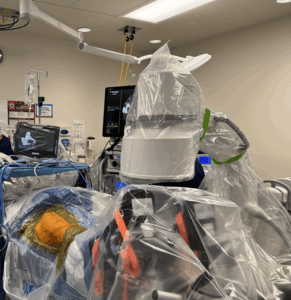
Figure 1: Operating room setup for computer-assisted visualization software.
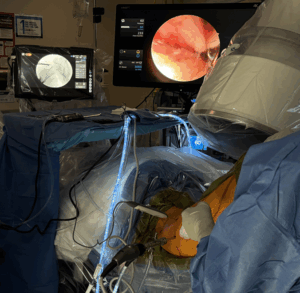
Figure 2: Intraoperative templating for cam resection by computer-assisted visualization software.
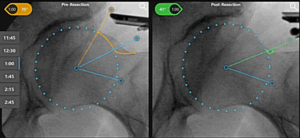
Figure 3: Computer-assisted guidance for measuring appropriate resection depth. Computer display demonstrating a pre-resection 75-degree alpha angle and post-resection 41-degree alpha angle at the 1:00 position in the left hip of a 25-year-old male with a large Cam deformity.
Statistical Analysis
A priori power analysis was performed to determine the minimum number of patients required to achieve at least 80% power. Assuming a mean 9-minute difference ( ± 10) in total femoroplasty time between groups, it was determined that 14 patients in each group would be needed for appropriate power. All statistical analyses were performed using Microsoft Excel (Microsoft Corp, Redmond, Washington) with the Real Statistics Add-in. Mean and standard deviation were calculated for all continuous variables. To assess normality and variance, the Shapiro-Wilk test and F-test were employed, respectively. Comparisons between the two groups were made using a student’s t-test or its non-parametric equivalent, the Mann-Whitney test. In the case of non-parametric data with unequal variances, the Welch test was performed. Categorical data was analyzed using a chi-squared test. Subgroup analyses comparing femoroplasty time between surgeons was performed in a similar manner. Significance was set at p < .05.
Results
Patient Demographics
Following randomization, 27 patients were allocated into the conventional fluoroscopy cohort while 24 patients were allocated to the CAV arm of the study. Secondary to technical complications with the C-Arm, intraoperative fluoroscopy time and radiation exposure was obtained on 18 and 19 patients for the conventional fluoroscopy and CAV groups respectively (Fig. 4). Demographic data is outlined in Table 2. The senior surgeon completed 74% of the cases in the CAV cohort compared to 78% in the conventional fluoroscopy group (p=0.95).
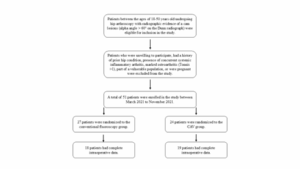
Figure 4: Patient selection flow chart. CAV: Computer-Assisted Visualization.
Computer Assisted Visualization (n=19) | Conventional Fluoroscopy (n=18) | p | |
Age | 43.3 ± 18.4 (17.2-72.5) | 44.0 ± 13.3 (16.5-65.9) | 0.888 |
Sex (Female) n (%) | 14 (74) | 10 (56) | 0.26 |
BMI | 26.34 ± 3.72 (21.9-33.2) | 27.64 ± 4.09 (21.0-34.0) | 0.364 |
Alpha Angle (º) | 66.9 ± 4.8 (62-79) | 65.7 ± 4.3 (60-74) | 0.32 |
Senior Surgeon Cases | 14 (74%) | 14 (78%) | 0.95 |
Values presented as mean ± standard deviation (range) unless otherwise noted. BMI: Body Mass Index. | |||
Table 2: Preoperative demographic data for the computer assisted visualization and conventional fluoroscopy cohorts.
Intraoperative Femoroplasty and Fluoroscopy Data
The median femoroplasty time for the conventional fluoroscopy group was 14 minutes (IQR 9-23.75) while the median femoroplasty time for the assisted visualization cohort was 15 minutes (IQR: 11-37). There were no statistical differences between the two groups for average femoroplasty time or fluoroscopy exposure (Table 3). There was a significant reduction in alpha angle between both groups (p<0.001) with no differences between groups (p=0.30). There were no intraoperative femoroplasty complications, unintended effects or harms identified between groups related to the study.
Computer Assisted Visualization (n=19) | Conventional Fluoroscopy (n=18) | p | |
Total Femoroplasty Time (min) | 23.0 ± 15.8 (7-68) | 17.8 ± 10.2 (6-41) | 0.29 |
Total Fluoroscopic Exposure (sec) | 56.8 ± 82.0 (8-382) | 39.8 ± 36.4 (3-137.9) | 0.45 |
Microgray Exposure (mGy) | 6.6 ± 3.8 (1.2-16.5) | 6.4 ± 5.1 (1.5-19.3) | 0.94 |
Alpha Angle(º) | 44.2 ± 4.4 (37.2-51.1) | 42.7 ± 4.2 (35.6-50.8) | 0.30 |
Values presented as mean ± standard deviation (range). | |||
Table 3: Intraoperative femoroplasty and fluoroscopic exposure data.
Surgeon Comparison
The senior surgeon had a significantly shorter femoroplasty time with less radiation exposure in the conventional fluoroscopy cohort compared to the less experienced surgeon (p<0.05; Table 4). For the senior surgeon, there was a non-significant increase in femoroplasty time and radiation exposure for the patients in the CAV group while there was a non-significant decrease in radiation exposure for the less experienced surgeon. There were no differences in femoroplasty time or radiation exposure between the senior and junior surgeons for CAV patients. For the junior surgeon, there was similar femoroplasty time between the conventional and CAV cohorts (31.0min vs. 29.4min; p=0.83) with lower radiation exposure time (91.0s vs. 44.1s; p=0.11) and dose (13.3 mGy vs. 8.9 mGy; p=0.36). For the junior surgeon there was no significant difference in postoperative alpha angle between the CAV and the conventional fluoroscopy groups (44.8° ± 4.3° vs. 47.4° ± 4.0°; p=0.85).
Senior Surgeon (n=28) | Junior Surgeon (n=9) | p | |
Femoroplasty Time (min) | |||
Conventional Fluoroscopy | 14.1 ± 7.3 | 31.0 ± 7.6 | 0.002 |
Computer Assisted Visualization | 20.1 ± 16.2 | 29.4 ± 10.1 | 0.27 |
p* | 0.24 | 0.82 | |
Fluoroscopic Exposure Time (s) | |||
Conventional Fluoroscopy | 28.0 ± 21.7 | 90.9 ± 42.5 | 0.004 |
Computer Assisted Visualization | 36.7 ± 22.8 | 44.1 ± 19.0 | 0.54 |
p* | 0.31 | 0.11 | |
Fluoroscopic Exposure Dose (mGy) | |||
Conventional Fluoroscopy | 4.9 ± 3.6 | 13.3 ± 5.2 | 0.03 |
Computer Assisted Visualization | 5.7 ± 2.7 | 8.9 ± 5.2 | 0.13 |
p* | 0.53 | 0.50 | |
Alpha Angle | |||
Preoperative (CAV) | 67.5 ± 5.4 | 65.4 ± 2.2 | 0.43 |
Intraoperative (CAV) | 40.5 ± 2.3 | 39.7 ± 1.2 | 0.60 |
p** | <0.001 | <0.001 | |
CAV: Computer Assisted Visualization software. p: Inter-surgeon differences between study groups. p*: Intra-surgeon differences between navigated and non-navigated groups. p**: Intra-surgeon differences between preoperative radiographic alpha angle and measured intraoperative alpha angle. | |||
Table 4: Surgeon comparison by experience.
Discussion
The present study demonstrates that in a randomized controlled trial, the use of computer assisted visualization software does not significantly increase femoroplasty time or radiation exposure. For the senior surgeon there was a non-significant increase in both femoroplasty time and radiation exposure, while the junior surgeon had no change in femoroplasty time and decreased radiation exposure and fluoroscopic exposure time in the CAV arm of the study. Femoroplasty accuracy, as defined by postoperative alpha angle, was comparable between the conventional fluoroscopy and CAV groups.
Appropriate management of proximal femoral asphericity as a part of FAIS surgical treatment impacts postoperative outcomes. Inadequate femoroplasty either through over-or under resection leads to inferior outcomes and increases rates of revision hip arthroscopy as well as early conversion to total hip arthroplasty [6]. Challenges to appropriate Cam resection include limited intraoperative visualization or an incomplete understanding of the three-dimensional geography of the cam deformity in relation to the femoral head-neck junction [19]. Historically, proximal femoral under-resection was a leading cause for patients requiring revision hip arthroscopy with Cvetanovich, et al., reporting residual FAI as an intraoperative finding in 81% of revision hip surgeries in a systematic review of 348 patients [10]. However, possibly in response to higher rates of under-resection, proximal femoral over-resection has been increasing in incidence and may be more common than under-resection in revision surgeries.8 Further, femoral over-resection is potentially more devastating with limited treatment options and higher rates of conversion to total hip arthroplasty [21,27]. In a 2018 study on 120 patients undergoing revision hip arthroscopy, Mansor and colleagues report inferior rates of achieving the MCID and PASS for patients who had an over-resection compared to patients with an under-resection or no proximal femoral deformity [21]. Further, the authors identified an increased rate of early conversion to arthroplasty in the over-resection group compared to the under-resection cohort (30% vs. 0%; p=0.02). These findings demonstrate that it can be particularly challenging to identify the true extent of a cam lesion solely through arthroscopic means and while fluoroscopy free techniques have been described, the majority of arthroscopic hip surgeons rely on intraoperative imaging to confirm satisfactory cam resection. Technological advances allowing for three-dimensional deformity visualization as well as intraoperative resection guidance are designed to reduce the rates of inaccurate femoroplasty [22]. From a preoperative standpoint, Tannast, et al., reported on the early utilization of a CT-based three dimensional modeling tool (HipMotion) to evaluate patient specific impingement positions through virtual range of motion analyses [31]. Three dimensional modeling software has been particularly valuable when considering torsional deformities and the decision making process for when to pursue a osteotomies in addition to hip arthroscopy [17,29]. Recently, an automated three dimensional hip modeling system was constructed using T1 VIBE sequencing on a 3T MRA which demonstrated high correlations to CT based models, demonstrating promising results for radiation free modeling [32]. Additionally, software such as HipMotion and MIMICs based modeling systems have also been employed to evaluate the effects of virtual osteoplasty on range of motion to aid in preoperative planning [5,17]. Commercially available comprehensive preoperative modeling platforms have been developed to assist surgeons with preoperative planning. The Smith and Nephew Dyonics PLAN (Smith and Nephew; Andover, MA) has been shown to accurately model the entirety of the cam deformity as well as prevent under-resection [1,13]. Similarly, the Stryker HipMap (Stryker Kalamazoo, MI, USA) is a commercially available three-dimensional modeling software platform which employs a low-dose radiation CT protocol to develop femoral and acetabular models. Advantages of HipMap include comprehensive measures of intra-and extra-articular impingement as well as deformity analyses incorporating anticipated resection depths and expected radiographic changes following a planned resection. Preoperative knowledge of the Cam deformity’s geographic location and extent, coupled with the ability to conceive a virtual osteoplasty, may aid the surgical approach and decision-making, particularly for developing hip preservation surgeons [3,13].
Intraoperative technology designed to increase femoroplasty accuracy and efficiency may particularly benefit surgeons earlier in the learning curve for hip arthroscopy. Dumont, et al., reported a significantly increased operative time for the first 75 cases, while Smith and colleagues found that radiation dose and fluoroscopy time decreased significantly over a single surgeon’s first 100 cases [12,30]. Integrating CT data with the Brainlab surgical navigation platform, Almoussa, et al., found that inexperienced surgeons were able to perform similar resections to experienced surgeons using a sawbones model [2]. However, when the platform was applied clinically by a senior surgeon, there was no difference in resection quality between the navigated and non-navigated groups [7]. Using the Orthomap 3D navigation software (Stryker; Mahwah, NJ, USA) integrated with a preoperative CT scan, Van Houcke, et al., found that postoperative alpha angle was significantly decreased in the navigated compared to the non-navigated cohort in a randomized control trial [15]. While navigation proved successful in decreasing the maximum alpha angle, the authors report that there remained a 13% rate of incomplete cam resection compared to a 29% rate of incomplete Cam resection in the non-navigated group (p>0.05). Using the computer assisted visualization software, the present study found a significant reduction in intraoperative alpha angle compared to preoperative radiographs. Further, for the experienced surgeon the CAV platform had a nonsignificant increase in femoroplasty time and radiation exposure while for the junior surgeon radiation exposure and femoroplasty time were non-significantly decreased. This was an improvement compared to the conventional fluoroscopy cohort where the less experienced surgeon had significantly longer femoroplasty time with increased radiation exposure compared to the experienced surgeon. This finding demonstrates a potential benefit of computer assisted deformity visualization even outside of the traditional learning curve, as the less experienced surgeon still had over one hundred arthroscopic cases in 2 years of experience prior to the onset of the study. It is possible that for surgeons in the traditional learning cuver (<100 cases), the benefits of CAV software would be even more apparent, however this requires additional study. The results of the present study compare well to a prior study comparing a senior and junior surgeon with the CAV softare where the authors found assisted visualization increased the accuracy of the femoroplasty without significantly affecting femoroplasty time in a cadaveric study [4]. Taken together, in the hands of a less experienced surgeon, computer assisted visualization may aid in achieving a highly accurate femoroplasty while potentially decreasing femoroplasty time and radiation exposure during the learning curve [25].
Strengths
The strengths of this study include the design as a randomized controlled trial as well as the standardized surgical technique for obtaining a spherical femoroplasty. Both surgeons had extensive experience in complex hip arthroscopy with the junior surgeon training under the senior surgeon prior to starting practice.
Limitations
This study has multiple limitations. While the study was initially powered to detect an 8-minute difference between conventional fluoroscopy and CAV arms, detecting a lesser difference may require a larger sample size in future studies. Further, the power analysis was not designed to detect differences between the senior and junior surgeon and the number of patients treated by the senior and junior surgeon were not identical. Additionally, patient-reported outcomes and postoperative variables were not included in the analysis, as this data is focused on intraoperative time and radiation exposure and postoperative outcomes are currently being collected in a prospective fashion. Despite these limitations, we believe that this study contributes valuable data regarding the value of intraoperative femoroplasty visualization software, particularly for junior hip preservation surgeons.
Conclusion
The image-based computer assisted visualization software does not significantly lengthen femoroplasty or fluoroscopy time during cam resection. Additionally, computer assisted visualization may decrease femoroplasty time and radiation exposure for less experienced surgeons, supporting this technology as a promising tool in achieving accurate and reliable cam resection during hip arthroscopy.
Conflict of Interests
The authors declare no conflict of interest. Dr. Kuhns serves on the editorial board for Arthroscopy.
Ms. Walsh has nothing to disclose. Dr. Lall has received consulting fees from Arthrex, Inc., Stryker Corp.; has received research support from Arthrex Inc., Medwest, Smith and Nephew, Stryker Corp., Vericel, Zimmer Biomet; has received any other financial or material support Arthrex Inc., Iroko, Medwest, Smith and Nephew, Stryker Corp., Vericel, Zimmer Biomet. Dr. Lall serves as the Medical Director of Hip Preservation at St. Alexius Medical Center and as a Clinical Instructor at the University of Illinois College of Medicine.
Dr. Domb has had ownership interests in the American Hip Institute and affiliates, North Shore Surgical Suites, and Munster Specialty Surgery Center; research support from Arthrex, Stryker, Smith and Nephew, and Ossur; consulting fees from Arthrex, Medacta, Stryker, and SI-Bone Inc; has received educational support from Arthrex, Stryker; speaking fees from Arthrex; travel and lodging from Arthrex and Stryker; food and beverage from Arthrex, DJO Global, Medacta, Stryker, Zimmer Biomet, DePuy Synthes Sales, Medtronic, Trice Medical, Medwest Associates, SI-Bone Inc, Xiros Inc, Intellijoint Surgical Inc, Electronic Waveform Lab Inc; royalties from Arthrex, DJO Global, Medacta, Orthomerica; patents with Arthrex, Orthomerica, and DJO Global. Dr. Domb is Director of Hip Preservation at St. Alexius Medical Center and a board member for the American Hip Institute Research Foundation, AANA Learning Center Committee, the Journal of Hip Preservation Surgery, Journal of Arthroscopy, AOSSM Research Committee, and ISHA Executive Board. The American Hip Institute Research Foundation (American Orthopedic Foundation) funds research and is where our study was performed.
Ethical Statement
This study was performed in accordance with the ethical standards in the 1964 Declaration of Helsinki. This study was carried out in accordance with relevant regulations of the US Health Insurance Portability and Accountability Act (HIPAA). Details that might disclose the identity of the subjects under study have been omitted. This study was approved by the IRB. (IRB Tracking Number: 20200279). This study is registered on ClinicalTrails.gov, with an ID number of: NCT04265222.
Consent of Publication
This study was performed at the American Hip Institute Research Foundation.
Authorship Contribution Statement
Benjamin D. Kuhns, MD, MS.-Data collection/analysis, writing, and revision of the manuscript.
Elizabeth G. Walsh, BS.-Data collection/analysis, writing, and revision of the manuscript.
Ajay C. Lall, MD, MS.-Data interpretation, writing, and revision of the manuscript.
Benjamin G. Domb, MD-Data interpretation, writing, and revision of the manuscript.
Funding/Sponsorship
Funding for the study was provided through a research grant by the Stryker Corporation (Kalamazoo, MI, USA).
References
- Ackerman GP, McHugh MP, Bharam S. The impact of preoperative planning software on arthroscopic correction of femoroacetabular impingement. Orthop J Sports Med. 2015;3(7_suppl2):2325967115S00056.
- Almoussa S, Barton C, Speirs AD, Gofton W, Beaulé PE. Computer-assisted correction of cam-type femoroacetabular impingement. J Bone Jt Surg. 2011;93(2):70-5.
- Alter TD, Knapik DM, Lambers F. Sex-based differences in femoroacetabular impingement syndrome and the effect of cam deformity location on the extent of labral tearing: A 3-dimensional computed tomography study. Orthop J Sports Med. 2022;10(5):23259671221095176.
- Beck EC, Chahla J, Krivicich L. Intraoperative Automated radiographic visualization tool allows for higher accuracy of cam lesion resection when used by novice surgeons for arthroscopic femoroplasty: Lowering the learning curve. Arthrosc: J Arthrosc Relat Surg. 2022;38(4):1156-63.
- Bedi A, Dolan M, Magennis E, Lipman J, Buly R, Kelly BT. Computer-assisted modeling of osseous impingement and resection in femoroacetabular impingement. Arthrosc: J Arthrosc Relat Surg. 2012;28(2):204-210.
- Bogunovic L, Gottlieb M, Pashos G, Baca G, Clohisy JC. Why do hip arthroscopy procedures fail? Clin Orthop Relat R. 2013;471(8):2523-9.
- Brunner A, Horisberger M, Herzog RF. Evaluation of a computed tomography-based navigation system prototype for hip arthroscopy in the treatment of femoroacetabular cam impingement. Arthrosc: J Arthrosc Relat Surg. 2009;25(4):382-91.
- Carbone AD, Prabhavalkar ON, Perez-Padilla PA, Curley AJ, Nerys-Figueroa J, Domb BG. Utility of 3D planning software in understanding residual proximal femoral deformity for planning of revision hip arthroscopy. Am J Sports Med. 2023:3635465231198051.
- Clohisy JC, Carlisle JC, Beaulé PE. A systematic approach to the plain radiographic evaluation of the young adult hip. J Bone Jt Surgery-american Volume. 2008;90(Suppl 4):47-66.
- Cvetanovich GL, Harris JD, Erickson B. Revision hip arthroscopy: A systematic review of diagnoses, operative findings and outcomes. Arthrosc J Arthrosc Relat Surg. 2015;31(7):1382-90.
- Domb BG, Annin S, Chen JW. Optimal treatment of cam morphology may change the natural history of femoroacetabular impingement. Am J Sports Med. 2020;48(12):2887-96.
- Dumont GD, Cohn RM, Gross MM, Menge TJ, Battle NC, Thier ZT. The learning curve in hip arthroscopy: Effect on surgical times in a single-surgeon cohort. Arthrosc: J Arthrosc Relat Surg. 2020;36(5):1293-8.
- Ellis SH, Perriman DM, Burns AWR, Neeman TM, Lynch JT, Smith PN. Total volume of cam deformity alone predicts outcome in arthroscopy for femoroacetabular impingement. Knee Surg, Sports Traumatol, Arthrosc. 2020;28(4):1283-9.
- Gosvig K, Jacobsen S, Palm H, Sonne-Holm S, Magnusson E. A new radiological index for assessing asphericity of the femoral head in cam impingement. J Bone Jt Surg Br. 2007;89(10):1309-16.
- Houcke JV, Khanduja V, Nakano N, Krekel P, Pattyn C, Audenaert E. Accuracy of navigated cam resection in femoroacetabular impingement: A randomised controlled trial. Int J Méd Robot Comput Assist Surg. 2017;13(4).
- JÄger M, Wild A, Westhoff B, Krauspe Rü. Femoroacetabular impingement caused by a femoral osseous head-neck bump deformity: clinical, radiological and experimental results. Journal of Orthopaedic Science. 2004;9(3):256-63.
- Kubiak-Langer M, Tannast M, Murphy SB, Siebenrock KA, Langlotz F. Range of motion in anterior femoroacetabular impingement. Clin Orthop Relat Res. 2007;458(NA;):117-24.
- Lall AC, Annin S, Chen JW. Achieving a perfectly spherical femoroplasty: pearls, pitfalls and optimal surgical technique. Arthrosc Techniques. 2020;9(3):e303-13.
- Lansdown DA, Kunze K, Ukwuani G, Waterman BR, Nho SJ. The importance of comprehensive cam correction: radiographic parameters are predictive of patient-reported outcome measures at 2 years after hip arthroscopy. Am J Sports Med. 2018;46(9):2072-8.
- Larson CM, Wulf CA. Intraoperative fluoroscopy for evaluation of bony resection during arthroscopic management of femoroacetabular impingement in the supine position. Arthrosc J Arthrosc Relat Surg Official Publ Arthrosc Assoc North Am Int Arthrosc Assoc. 2009;25(10):1183-92.
- Mansor Y, Perets I, Close MR, Mu BH, Domb BG. In search of the spherical femoroplasty: cam overresection leads to inferior functional scores before and after revision hip arthroscopic surgery. Am J Sports Medicine. 2018;46(9):2061-71.
- Nakano N, Audenaert E, Ranawat A, Khanduja V. Review: Current concepts in computer‐assisted hip arthroscopy. Int J Méd Robot Comput Assist Surg. 2018;14(6):e1929.
- Nepple JJ, Parilla FW, Ince DC, Freiman S, Clohisy JC. Does femoral osteoplasty improve long-term clinical outcomes and survivorship of hip arthroscopy?15-year minimum follow-up study. Am J Sports Medicine. 2022;50(13):3586-92.
- Owens JS, Saks BR, Fox JD, Jimenez AE, Lall AC, Domb BG. The circumferential femoroplasty: An all-arthroscopic technique for addressing a challenging hip deformity. Arthrosc Tech. 2022;11(10):e1737-45.
- Perry AK, DeFroda SF, Gursoy S. Top ten pearls for successful hip arthroscopy for femoroacetabular impingement. Arthrosc Tech. 2021;10(8):e2033-42.
- Pierannunzii L. Femoroacetabular impingement: question-driven review of hip joint pathophysiology from asymptomatic skeletal deformity to end-stage osteoarthritis. J Orthop Traumatol. 2019;20(1):32.
- Rodkey DL, Dickens JF, Tintle S. Femoral neck over-resection after hip arthroscopy treated with vascularized fibula autograft. JBJS Case Connect. 2021;11(3):e21.00203.
- Ross JR, Bedi A, Stone RM. Intraoperative fluoroscopic imaging to treat cam deformities: correlation with 3-dimensional computed tomography. Am J Sports Medicine. 2014;42(6):1370-6.
- Siebenrock KA, Steppacher S, Haefeli P, Schwab J, Tannast M. Valgus hip with high antetorsion causes pain through posterior extraarticular FAI. Clin Orthop Relat R. 2013;471(12):3774-80.
- Smith KM, Duplantier NL, Crump KH. Fluoroscopy learning curve in hip arthroscopy: A single surgeon’s experience. Arthrosc: J Arthrosc Relat Surg. 2017;33(10):1804-9.
- Tannast M, Kubiak‐Langer M, Langlotz F, Puls M, Murphy SB, Siebenrock KA. Noninvasive three‐dimensional assessment of femoroacetabular impingement. J Orthop Res. 2007;25(1):122-31.
- Zeng G, Degonda C, Boschung A. Three-dimensional magnetic resonance imaging bone models of the hip joint using deep learning: Dynamic simulation of hip impingement for diagnosis of intra- and extra-articular hip impingement. Orthop J Sports Med. 2021;9(12):23259671211046916.
Author Info
Benjamin D Kuhns1, Elizabeth G Walsh1, Ajay C Lall1,2, Benjamin G Domb1,2*
1American Hip Institute Research Foundation, Chicago, IL 60018, USA
2American Hip Institute, Chicago, IL 60018, USA
*Correspondence author: Benjamin G Domb, MD, American Hip Institute Research Foundation, Chicago, IL 60018, USA and American Hip Institute, Chicago, IL 60018, USA;
Email: [email protected]
Copyright
Benjamin D Kuhns1, Elizabeth G Walsh1, Ajay C Lall1,2, Benjamin G Domb1,2*
1American Hip Institute Research Foundation, Chicago, IL 60018, USA
2American Hip Institute, Chicago, IL 60018, USA
*Correspondence author: Benjamin G Domb, MD, American Hip Institute Research Foundation, Chicago, IL 60018, USA and American Hip Institute, Chicago, IL 60018, USA;
Email: [email protected]
Copyright© 2025 by Kuhns BD, et al. All rights reserved. This is an open access article distributed under the terms of the Creative Commons Attribution License, which permits unrestricted use, distribution, and reproduction in any medium, provided the original author and source are credited.
Citation
Citation: Kuhns BD, et al. Achieving a Spherical Femoroplasty During Hip Arthroscopy with Computer Assisted Visualization Software: A Prospective Single-Blinded Randomized Controlled Multi-Surgeon Study. J Ortho Sci Res. 2025;6(2):1-10.

